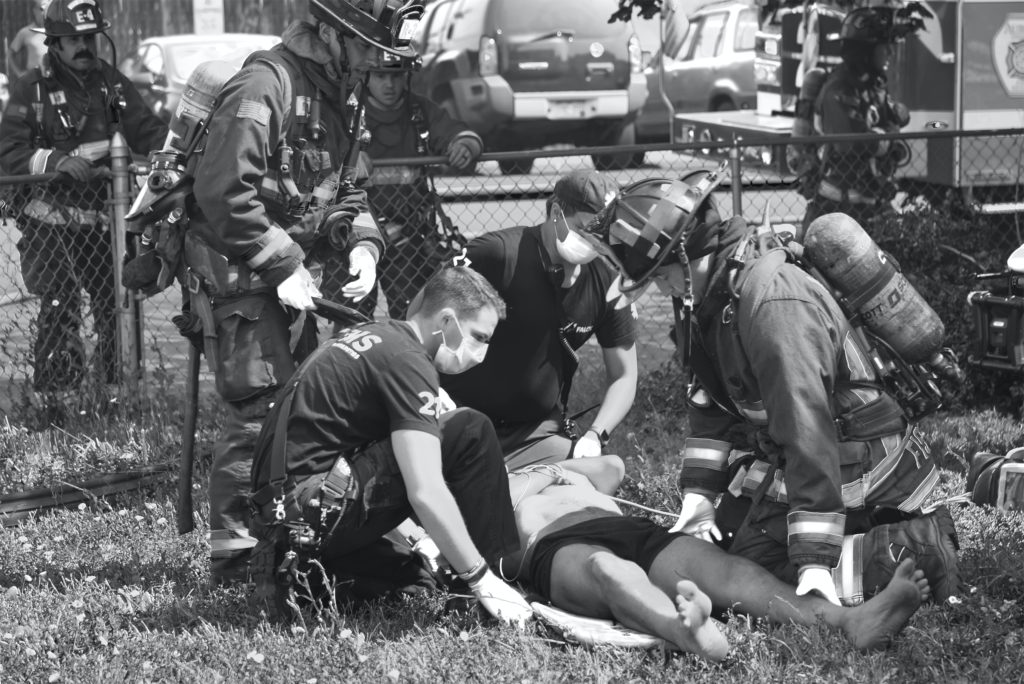You may always find EMS personnel (paramedic and emt) helping people who are experiencing medical emergencies or rescuing accident victims on the news or in TV dramas. The majority of EMS responders hold either an EMT or paramedic level of certification. Both perform their work in a range of capacities and healthcare environments. They frequently work with fire departments, industrial safety, ground ambulances, and helicopters.

What makes them different from one another if they both help patients and wear uniforms?
There are various levels of provider certifications in the emergency medical services (EMS) industry. The most prevalent EMS service providers are Emergency Medical Technicians (EMTs), also known as EMTs. The fundamental abilities needed to assist in life-threatening situations are taught to EMTs, and many of them go on to obtain an Advanced EMT credential or become Paramedics. Numerous physicians, nurses, and firefighters have also used their EMT training and employment as stepping stones in their professional careers.
Students who want to become Emergency Medical Technicians (EMT) must finish a course that lasts at least 170 hours. EMTs are trained to assess patients and identify any potential life-threatening injuries or illnesses. This includes providing life-saving epinephrine to a patient having an allergic reaction, splinting injuries for a patient following a car accident, or even doing CPR on a patient experiencing cardiac arrest. The EMT will also learn how to deliver a newborn, use a bag valve mask to ventilate, administer oxygen, and even administer various drugs. The best tool in an EMT's toolbox and the main focus of their training is assessment, or the ability to swiftly determine if someone is dying.
The majority of the time, no prior medical training is required in order to participate in an EMT course. Schools may have different eligibility standards and prerequisites for their EMT and paramedic course. Before enrolling in a course, make sure to verify the regulations of the institution and your state. For instance, in California, becoming a certified EMT requires that you be at least 18 years old.
Students enrolled in the Paramedic (PM) course must finish a course load of 1,200–1,800 hours over the course of six–12 months. Anatomy and physiology, cardiology, drugs, and medical procedures are all included in paramedic courses. Training for paramedics builds on EMT instruction and teaches skills including inserting intravenous lines, managing advanced airways, interpreting patient EKGs, and learning how to treat patients who are experiencing life-threatening medical or traumatic emergencies.
A paramedic must be prepared to aid patients during their shift, whether it is caring for car accident victims, reading an EKG for a heart attack patient, or giving birth. It never becomes dull! Students are trained to pass the national certification examinations and earn the highest level of certification for pre-hospital care providers through a combination of lectures, skills labs, hospital internships, and EMS field internships.
You must be an EMT and typically have at least six months of work experience as an EMT in order to be eligible for a paramedic course. There could be variations in the entry requirements for paramedic courses. Several have personal health criteria such as confirmation of vaccination and a physical as an entry requirement. Some require you to study college-level Anatomy and Physiology before admittance.
To assess your eligibility for admission, schools may also need a criminal background check, an admissions interview, or an entrance exam. Although the standards vary widely amongst schools, the objective is to choose applicants who will be successful in the training course.
An individual must complete 120 to 150 hours of training in emergency care and basic life support in order to become an EMT.
An individual must complete the EMT course requirements in order to become a paramedic, and then build on this knowledge with 1200–1800 hours of further training over a two-year degree course. Not every EMT decides to pursue paramedic training.
Understanding the basics of paramedics and knowing how to work with them is critical to your family’s medical situation in ambulances and hospitals.
A paramedic is trained to act in an emergency setting.
In the case of an emergency patient situation, they’re the ones who act quickly to follow the correct procedures and set up the right equipment.
Medical professionals like doctors and nurses may not be able to keep up with the emergency situation as their job requires them to think clearly.
Paramedics are skilled at quickly assessing the situation and taking action. Achieving this requires them to undergo tons of practice with a standard operating procedure in mind, freeing them from unnecessary distraction
They set the stage for the doctors and nurses to do their best to provide maximum life support to emergency patients and save human lives.
An electrocardiogram monitor is used to keep a record of the patient's vital signs while they are being transported.
A defibrillator can be used to stabilize a heart that is experiencing cardiac arrest or to revive a patient who is in the process of collapsing.
Pieces of medical equipment that are used in ambulances to provide a method of immobilization and transportation for patients who may have sustained injuries to their spine. The spinal board responders have the ability to lift the patient in difficult circumstances, whether they are extricating them or transporting them.
An automatic transport mechanical ventilator is a piece of medical equipment that is designed to be used in place of bagging (manual ventilation) when a patient who is unable to breathe on their own is being transported to a hospital.
When the patient is experiencing internal bleeding and needs the pressure that has been building up on vital organs to be relieved. It is also used to remove fluids that have collected inside the body or the mouth, as well as in situations that require an emergency procedure to be performed on the patient in the ambulance equipment before the patient is taken to the hospital.
An infusion (or withdrawal) syringe pump is a piece of medical equipment that can either infuse or withdraw liquid into or from the patient's body at a defined flow rate and controlled target volumes. It can also do either of these things at the same time.
When a patient is located on a higher floor of a building, cannot move, or may make their condition worse by moving, cots are an extremely helpful piece of medical equipment. Patients who have sustained injuries to their spinal column are fitted with specialized spinal support boards and collars before being transported. Shifting rolls are essential to perform if your patient has not sustained a traumatic injury but is unable to move independently using his legs. However, the ambulance chair is the piece of medical equipment that is used to transport patients from their homes to the interior of an ambulance the most frequently.
Standard equipment for determining one's blood pressure is represented by the sphygmo. It consists of an inflatable rubber cuff that is wrapped around the arm and connected to a spring in a mechanical manometer that is placed next to a graduated scale. This configuration makes it possible to determine both the systolic and diastolic blood pressures by gradually increasing and decreasing the amount of pressure that is contained within the cuff. The blood pressure of a patient who requires immediate medical attention can be determined with the help of this instrument.
Paramedical colleges are the gateway to acquiring a professional career in the paramedical field. The highest level of emergency medical service provided by a community is provided by paramedics. Patients who are in the process of being transported to hospitals receive advanced emergency care from these professionals.
Those who are interested in becoming paramedics are typically required to first obtain training as an emergency medical technician (EMT) with basic qualifications and then gain some experience working in the field. They are then able to enroll in a program to become a paramedic, which will provide them with hands-on training and frequently lead to the completion of an associate's degree.
Graduates typically require paramedic certification from the National Registry of Emergency Medical Technicians (NREMT) in order to become state licensed, despite the fact that individual states often administer their own exams for this purpose.
